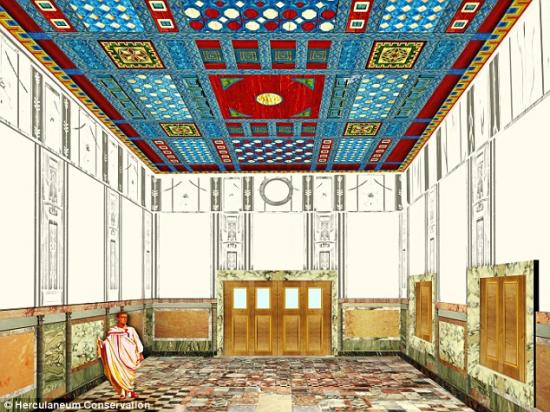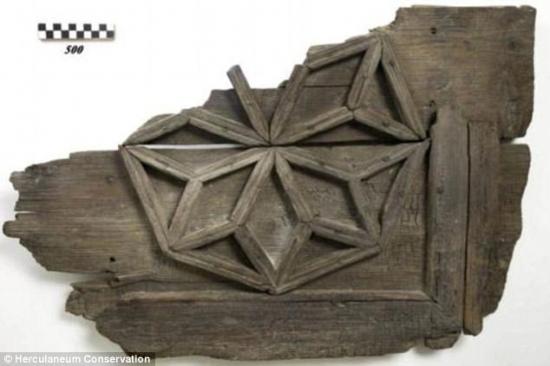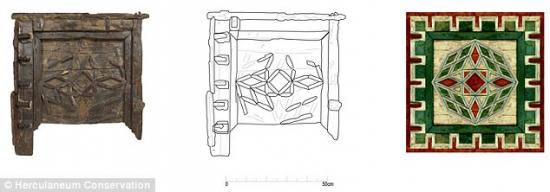Roman palace's stunning ceiling destroyed 2,000 years ago is finally restored from flecks of paint
Daisy Dunne
Source - http://www.dailymail.co.uk/sciencetech/article-4352322/Roman-palace-hit-Mount-Vesuvius-restored-scientists.html
The roof of a seaside Roman palace destroyed by a volcanic eruption more than 2,000 years ago has been restored by scientists.
Broken timber from the brightly-coloured three-story building was unearthed by archaeologists working on a beach near the ruined city of Herculaneum in Italy.
Scientists were able to restore the palace's red, blue, yellow and green roof tiles by analysing paint traces from the recovered timber.
 Scientists were able to restore the red, blue, yellow and green roof tiles of a seaside palace destroyed by the eruption of Mount Vesuvius in AD79. Pictured is a reconstruction
Scientists were able to restore the red, blue, yellow and green roof tiles of a seaside palace destroyed by the eruption of Mount Vesuvius in AD79. Pictured is a reconstruction
The palace, known as the House of Telephus, was destroyed when Mount Vesuvius erupted in AD79 and engulfed the ancient cities of Pompeii and Herculaneum.
The House of the Telephus Relief, a grand mansion, is believed to have been home to Marcus Nonius Balbus, the Roman governor of Crete.
Professor Andrew Wallace-Hadrill, the director of the Herculaneum Conservation Project (HCP), told the MailOnline: 'The excavation of the roof and ceiling started in 2008 and took place over several years.
'It's a very complex process. You've got to excavate it, work on it and then understand it why it is the way it is.
'The restoration of the colours of the roof took two or three years.'
The elaborate palace featured a 30ft (nine-metre) high grand dining room with marble floors and a gilded multi-coloured ceiling.
 The timbers of the roof, which were built into an inverted V-shape, were cut so precisely that no nails were required to hold them in place
The timbers of the roof, which were built into an inverted V-shape, were cut so precisely that no nails were required to hold them in place
The seaside dining room would have had stunning views of the Bay of Naples, the researchers said.
To reconstruct the room's roof, scientists uploaded the intricate pieces of timber to a computer using a 3D scanner.
'The originals were too delicate to handle and play around with,' Professor Wallace-Hadrill said.
'So a 3D scanner was used to help us slot all the pieces together.'
This process allowed researchers to discover that the timbers of the dining room's roof were built into an inverted V-shape and were cut so precisely that no nails were required to hold them in place.
To understand how what colours the gilded roof tiles would have been painted, researchers started by analysing traces of paint found on the excavated timber.
'They took all the evidence of all the flakes of paint, extracted from the painted panels,' Professor Wallace-Hadrill said, explaining how his Italian colleagues reconstructed the roof.
 To reconstruct the room's roof, scientists uploaded the intricate pieces of timber to a computer using a 3D scanner
To reconstruct the room's roof, scientists uploaded the intricate pieces of timber to a computer using a 3D scanner
'Then they said: "How do you put all the pieces together?"
'At first, they thought maybe the pattern of the ceiling matched that of the highly-coloured marble floor. But that didn't work.
'Then they said: "What if the pattern matches the marble panels of the walls?"
'And this time they were right.'
The palace was engulfed when pyroclastic flows sparked by the eruption of Mount Vesuvius hit the seaside town of Herculaneum.
Pyroclastic flows are a dense collection of hot gas and volcanic materials that flow down the side of an erupting volcano at high speed.
 Broken timber (pictured) from the brightly-coloured three-story building was unearthed by archaeologists working on a beach near the ruined city of Herculaneum in Italy
Broken timber (pictured) from the brightly-coloured three-story building was unearthed by archaeologists working on a beach near the ruined city of Herculaneum in Italy
Pyroclastic flows are more dangerous than lava because they travel faster, at speeds of around 450mph (700 km/h), and at temperatures of 1,000°C (1,830°F).
Mount Vesuvius, on the west coast of Italy, is the only active volcano in continental Europe and is thought to be one of the most dangerous volcanoes in the world.
When it erupted in AD79, tides of burning-hot debris engulfed the seaside mansion.
But by a fluke of geology, the timber of the building was protected for thousands of years between layers of sand.
'We've only got one third of the roof reconstructed,' Professor Wallace-Hadrill said.
'Half of the house is under 13 metres [43ft] of volcanic rock and we can't excavate that.'
HOUSE OF TELEPHUS
The House of the Telephus Relief is a three-storey palace that was preserved in a layer of sand after Mount Vesuvius destroyed the Roman town of Herculaneum in AD79.
It was discovered eight years ago by an Italian archaeologist from the Herculaneum Conservation Project (HCP).
Archaeologists discovered long beams – each up to seven metres long - which they pieced together to reconstruct the roof.
They were able to recreate the pattern of the panels from delicate traces of reds, blues, yellows and greens that were still on the wood.
Experts believe it is the only preserved Roman timber roof and described the find as ‘unique’.